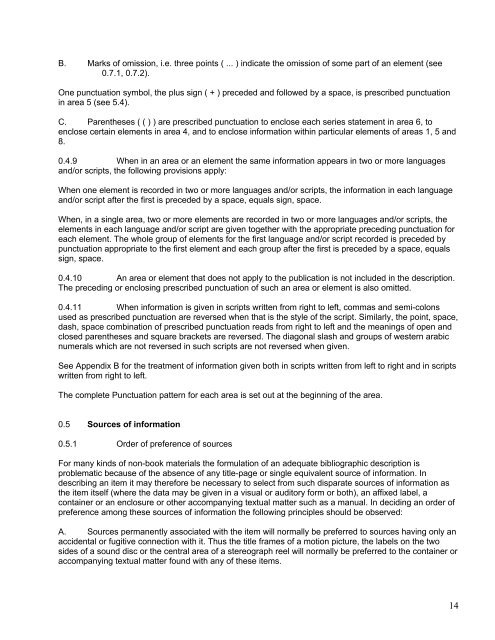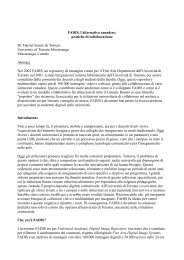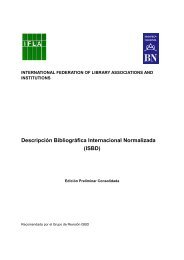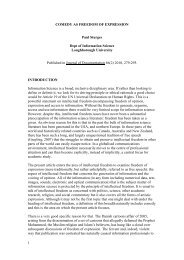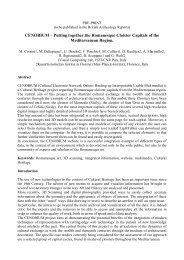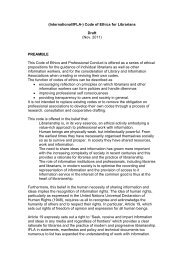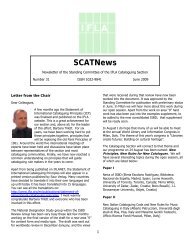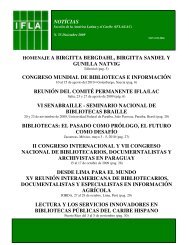ISBD(NBM) - IFLA
ISBD(NBM) - IFLA
ISBD(NBM) - IFLA
Create successful ePaper yourself
Turn your PDF publications into a flip-book with our unique Google optimized e-Paper software.
B. Marks of omission, i.e. three points ( ... ) indicate the omission of some part of an element (see<br />
0.7.1, 0.7.2).<br />
One punctuation symbol, the plus sign ( + ) preceded and followed by a space, is prescribed punctuation<br />
in area 5 (see 5.4).<br />
C. Parentheses ( ( ) ) are prescribed punctuation to enclose each series statement in area 6, to<br />
enclose certain elements in area 4, and to enclose information within particular elements of areas 1, 5 and<br />
8.<br />
0.4.9 When in an area or an element the same information appears in two or more languages<br />
and/or scripts, the following provisions apply:<br />
When one element is recorded in two or more languages and/or scripts, the information in each language<br />
and/or script after the first is preceded by a space, equals sign, space.<br />
When, in a single area, two or more elements are recorded in two or more languages and/or scripts, the<br />
elements in each language and/or script are given together with the appropriate preceding punctuation for<br />
each element. The whole group of elements for the first language and/or script recorded is preceded by<br />
punctuation appropriate to the first element and each group after the first is preceded by a space, equals<br />
sign, space.<br />
0.4.10 An area or element that does not apply to the publication is not included in the description.<br />
The preceding or enclosing prescribed punctuation of such an area or element is also omitted.<br />
0.4.11 When information is given in scripts written from right to left, commas and semi-colons<br />
used as prescribed punctuation are reversed when that is the style of the script. Similarly, the point, space,<br />
dash, space combination of prescribed punctuation reads from right to left and the meanings of open and<br />
closed parentheses and square brackets are reversed. The diagonal slash and groups of western arabic<br />
numerals which are not reversed in such scripts are not reversed when given.<br />
See Appendix B for the treatment of information given both in scripts written from left to right and in scripts<br />
written from right to left.<br />
The complete Punctuation pattern for each area is set out at the beginning of the area.<br />
0.5 Sources of information<br />
0.5.1 Order of preference of sources<br />
For many kinds of non-book materials the formulation of an adequate bibliographic description is<br />
problematic because of the absence of any title-page or single equivalent source of information. In<br />
describing an item it may therefore be necessary to select from such disparate sources of information as<br />
the item itself (where the data may be given in a visual or auditory form or both), an affixed label, a<br />
container or an enclosure or other accompanying textual matter such as a manual. In deciding an order of<br />
preference among these sources of information the following principles should be observed:<br />
A. Sources permanently associated with the item will normally be preferred to sources having only an<br />
accidental or fugitive connection with it. Thus the title frames of a motion picture, the labels on the two<br />
sides of a sound disc or the central area of a stereograph reel will normally be preferred to the container or<br />
accompanying textual matter found with any of these items.<br />
14


